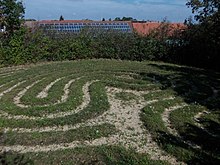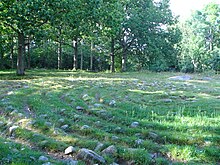Troy Castle
As Trojaburggen ( Swedish Trojeborg , plural Trojeborgar or Jungfrudans ; Finnish Jatulintarha - German maiden dance ) are stone settings in a pseudo - labyrinthine loop-like shape made of fist- to head-sized stones.
The diameters of the systems are between five and 25 m. The stones lie in endless rows, mostly loosely close to one another on the ground, they form an accessible, unbranched (endless) path system. The curvilinear figure was created independently of one another in different cultures and appears in many variants, not only in Europe ( Dunure Labyrinth , Mollerup Skov ), but also in the New World , for example in the Nazca culture in Peru and among the North American Hopi - Indians.
Troy castles were or are often found near the coast and on islands ( Gotland ), more rarely in the interior (e.g. Labyrinth of Tibble ). In terms of layout and size, they are similar to the lawn labyrinths, which are sometimes also referred to as Troy castles .
Archaeologists and ethnologists began to take an interest in these sites in the 19th century . Most of the Troy castles are in the Scandinavian region; There are about 300 in Sweden , about 200 have been found in Finland , about 60 are in Russia ( labyrinths on Bolshoi Sajazki ), 20 in Norway and some in Germany ( Trojaburg Calbe ).
Age, origin, purpose


One of the oldest depictions, in which a labyrinth is connected to the term Troy, ( Troy ), was made on an Etruscan vase from Tragliatella from the 7th century BC. Found where the name "Truia" is carved. The shape was already known in Europe in antiquity and appeared on Greek coins. A well-known wall drawing in Pompeii with the text "HIC HABITAT MINOTAVRUS" connects it with the legend of the Minotaur and the legendary labyrinth of Knossos on Crete . Other labyrinths can be found in medieval church paintings in Denmark, Sweden (Hablingbo), France and Italy. Estimates of the age of the Troy castles differ from one another: most of the Troy castles are apparently of recent origin (19th and 20th centuries). This is difficult as there are only a few plants with written certificates. An age determination , with the lichenometry be tried. The purpose for which the stone labyrinths were used is unknown. Suggested explanations are dance games ("Jungfrudans") in the Middle Ages, training of battle horses and religious rites.
Troy castles
- Sweden
- Blå Jungfrun, 15 rings
- Borås
- Bunge, Gotland
- Fröjel , Gotland
- Lindbacke
- Majbacken, Gotland
- Labyrinth of Tibble 15 rings
- Elmekärr 11 rings; also called "Trälleborgs slot" (also Trelleborg; Eng. Trolleburg). The connection between Trelle- and Trojaborg is more common.
- Visby, Gotland
- Germany
- Trojaburg Calbe near Calbe (Saale)
- Trojaburg in Graitschen auf der Höhe (Saale-Holzland-Kreis, Thuringia)
- Trojaburg near Steigra (Saalekreis, Saxony-Anhalt)
- Trojaburg Uckersdorf near Schwarzhofen, Bavaria
- Denmark
- Rørslev on Funen
- Eq. Holtegård on Zealand
- Finland
- Maaria Kyrka (Turku) labyrinth and swastika as wall painting
- Nagu
- Perna
- Sipoo (Sibbo)
- Norway
- Seljord
- Vestre Sildre
The Norwegian labyrinths form the western group. It is noticeable that they are not found in churches. In Seljord one is painted on the western facade near the entrance. In Vestre Slidre there is one on the outside of the church door. The location of the labyrinths could suggest that they served an apotropaic purpose. Labyrinths on or next to church doors remain restricted to Norway.
literature
- Christina Bäcksbacka: Stenlabyrinter i Finland. Finska Fornminnesföreningens Månadsblad (1972)
- Frithjoff Hallmann: The riddle of the labyrinths . Ardagger, Damböck 1994, ISBN 3-900589-15-1 .
- Waltraud Hunke : The Troy castles and their meaning . Dissertation. Munich 1941.
- John Kraft: The goddess in the labyrinth . edition amalia, Bern 1997, ISBN 3-905581-00-0 .
- Hermann Kern: Labyrinths . 4th edition. Prestel, Munich 1999, ISBN 3-7913-0614-6 .
- Dennis Krüger: The symbol of the Troy Castle . In: Trojaburg . 3/2006.
- Mechthild Meinike: The Troy Castle of Steigra . In: Megalithos . 3/2005.
- Reinhard Schmoeckel : The Trojamär in the early Franconian sources . In: Trojaburg . 1/2006.
- Siegfried Schumann: In the spell of Troy castles, holy stones and places of worship. Bottendorf 2015
Web links
- Lecture on labyrinths (Eichfelder's private website)
- mymaze Swedish Troy castles
- Fröjel on Gotland Sweden
- "Jungfrudans" at Üto ( Memento from January 23, 2013 in the web archive archive.today )
References and comments
- ↑ Sig Lonegren: Labyrinths , ISBN 978-0-906362-69-3 , 4th edition 2007. Archived copy ( Memento of the original from May 6, 2015 in the Internet Archive ) Info: The archive link was inserted automatically and has not yet been checked. Please check the original and archive link according to the instructions and then remove this notice. , accessed June 12, 2015
- ↑ Trojeborgen frescoes from the 15th century can be seen in four Danish village churches . They have been registered and painted over in six other churches. In Gevninge Church near Roskilde there are two about 50 cm in diameter on the wall above the altar arch. On one of the vaults in the church of Hesselager in the eastern Funen there is a labyrinth about 40 cm in diameter. In the old church of Skive there is one on the west wall, about 125 cm in diameter and half hidden behind the organ. A particularly beautiful labyrinth is in the church of Roerslev east of Middelfart . The two-colored Troeborg lies above the altar arch and measures 125 × 110 cm.





